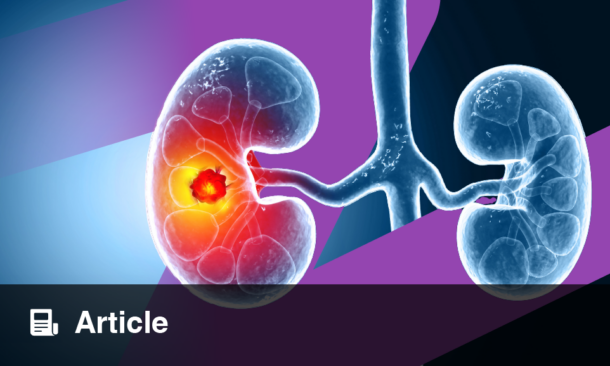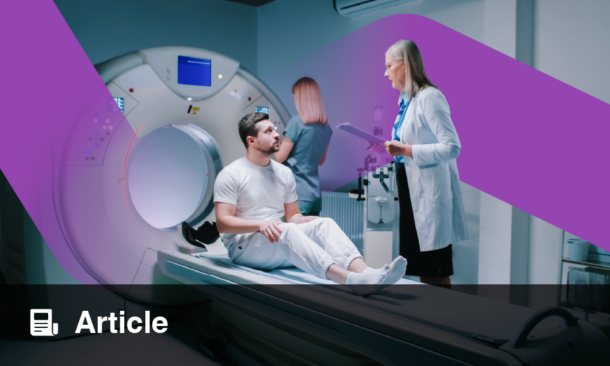A SPECTACLE as always, this year’s European Congress of Radiology (ECR) in Vienna, Austria, opened with a wealth of entrancing performances, ranging from dancers and acrobats imitating the natural world to dazzling singers gracing the stage. As the first dancers slipped off stage and the crowd erupted into applause, this year’s ECR President, Andrea Rockall, Imperial College London, UK, took the stage to welcome over 20,000 attendees from all over the world and to introduce the theme of ECR 2025: Planet Radiology. Sustainability was at the forefront not only of the opening ceremony but of every insightful session at this year’s congress, as experts from around the globe gathered to share knowledge, research, and innovation, with the hope of creating a more sustainable and inclusive future for us all.
At this year’s opening ceremony, aptly entitled ‘WONDER’, Rockall began her introduction by discussing the vow that all healthcare professionals take, ‘do no harm’, and the unintentional harm caused by the first doctors to use radiation in imaging. This led to some of the most vital early research and innovation in the field. Today, the radiation dose of a hand X-ray is 1,500 times less than it was originally, well over 100 years ago, and the image quality is far superior. However, Rockall went on to point out that the world now faces another invisible harm: global warming. “Global warming has been identified by the WHO as the biggest threat to health in our time,” and, seeing the temperature changes in recent decades presented on the screen during her introduction, it is no wonder that this is the case. “Caring for our planet is an integral part of caring for our patients,” emphasised Rockall, demonstrating to the captive audience why they should care about these rising temperatures, and urging them to engage with the theme of this year’s congress.
Rockall went on to discuss the work of the European Society of Radiology (ESR) and their industry partners in influencing policy and legislation, as well as education. This includes efforts such as the new European School of Radiology Sustainability Course, and the ESR Green Imaging Scheme, joined by over 20 departments since the beginning of 2025. To highlight the collaboration between ESR and other organisations throughout Europe, Patrizia Cornacchione, President of the European Federation of Radiographer Societies, joined Rockall on stage. Cornacchione expressed her hope that ECR 2025 will bring people together and that the connections and knowledge gained at this year’s congress will go on to shape radiology and radiography practices in the future.
The first part of the opening ceremony closed with an inspiring speech from Emma Baines, Deputy Head of Mission at the British Embassy, Vienna, Austria, highlighting the profound impact of international collaboration in the face of increasingly complex global challenges. Baines described the work being done by the UK government to safeguard the planet for future generations, including the Design For Life Roadmap, aiming to avoid single-use medical technology. However, she emphasised the need for collaboration across borders to bring together the brightest minds from across the globe and help save our planet.
The partnership between ESR and the International Atomic Energy Agency was highlighted during Rockall’s subsequent speech, as she elaborated on their work to harness the power of imaging in order to enhance healthcare, ensure patient safety, and drive innovation worldwide. To speak more about this, Rafael Grossi, Director General of the International Atomic Energy Agency, was invited to the stage. Explaining the vital work done by the agency around the world, Grossi delved into the ways in which industry partners, AI, cloud-based solutions, and interdepartmental collaboration can impact the future of imaging in healthcare. He also emphasised the importance of not leaving anyone behind, highlighting the necessity of capacity building and educational efforts in low- and middle-income countries.
Rockall’s subsequent talk only sought to drive this point home further. The theme for this year, she excitedly told the audience, was not simply Planet Radiology, but was focused on radiologists fixing the world. She had searched high and low throughout the imaging community to find the most inspiring projects with this in mind. A social campaign simply titled, ‘Share Your Story’, asked individuals to send their projects to ESR, and the response was overwhelming. Over 230 applicants from 72 countries, including industry researchers, practicing radiologists, charities, and more, submitted their heartwarming projects, detailing how they hope to do their part in fixing the world with their incredible work. The ‘In-Focus’ programme at ECR this year gave each of these applicants a platform to share their remarkable work taking place around the world, often with few resources.
Angela Ammirabile, Humanitas University, Milan, Italy, took to the stage to discuss one essential part of fixing the world: gender equality in radiology. In 2024, roughly 40% of ESR members were women; however, this varied vastly between generations. Only 21% of ESR members in the ‘baby boomer’ generation were women, while 50% of Generation Z members were female. This positive trend is the result of education efforts around Europe; however, there are still vital gaps. Only five women have held the title of President of ESR in its long history, a number that will grow to six next year. Additionally, there is a noticeable lack of female first and last authors in papers, as well as on the editorial boards of ESR journals. Ammirable pointed out that although there is promising work happening to entice women to the field, more needs to be done to achieve true equality.
As the opening ceremony continued, gold medals were presented to notable figures such as Rosemarie Forstner, Associate Professor of Radiology, University of Salzburg, Austria, and first female president of the Austrian Society of Radiology, and David Howlett, Consultant Radiologist, Eastbourne Hospital, UK, for their pioneering work in the field. Harriet Thoeny, Professor and Chair of Radiology, University Hospital Freiburg, Germany, was also amongst the extraordinary radiologists receiving a gold medal, though this may have paled in comparison to her partner joining her on stage to propose.
The ceremony was certainly one to remember for everyone watching, emphasising the need for collaboration, communication, and education in order to build a better and more equal world for future generations. ECR 2025 started as it went on, and the following days were filled with insightful abstracts, expert lectures, and fascinating research, as the best and brightest in the field of radiology came together to align on building a more sustainable practice. Read on for more insights into this year’s congress, and be sure to return for our coverage of ECR 2026, which will once again be held in Vienna, Austria, from 4th–8th March 2026.
Key Imaging Insights into Orbital Pathologies
A THOROUGH understanding of orbital pathologies is essential for accurate diagnosis and treatment planning, given the wide range of conditions affecting this complex anatomical region. Recent research presented at ECR 2025 has highlighted the critical role of imaging in distinguishing between various orbital disorders, from post-traumatic injuries to tumours, inflammatory diseases, and vascular anomalies.1
Orbital trauma remains a significant concern, with fractures of the orbital walls often resulting in complications such as herniation of orbital fat, extraocular muscle entrapment, and, in severe cases, globe rupture. Imaging plays a crucial role in evaluating these injuries, ensuring prompt identification of structural damage and guiding surgical intervention when necessary. Advanced CT and MRI techniques are instrumental in detecting subtle fractures, assessing ocular integrity, and ruling out associated vascular complications such as carotid-cavernous fistulas.
Beyond trauma, orbital tumours present a diagnostic challenge due to their diverse origins and imaging characteristics. Primary tumours such as lymphoma and optic nerve glioma exhibit distinct imaging patterns that aid in differentiating them from secondary metastatic lesions, commonly arising from lung and breast cancer. MRI remains the modality of choice for evaluating these tumours, with contrast-enhanced sequences providing essential details on tumour margins, vascular involvement, and potential malignancy.
Inflammatory and infectious conditions, including Tolosa-Hunt syndrome, dacryocystitis, and orbital cellulitis, also require careful imaging assessment. These conditions can often mimic neoplastic processes, necessitating a detailed evaluation of orbital fat stranding, sinus involvement, and soft tissue enhancement to guide appropriate management. Similarly, optic neuritis, frequently linked to autoimmune conditions such as multiple sclerosis, presents with characteristic MRI findings, including T2 hyperintensity and gadolinium enhancement of the optic nerve.
Vascular pathologies, including carotid-cavernous fistulas and orbital varices, represent another crucial area of orbital imaging. These conditions can lead to significant visual impairment if not promptly diagnosed. Imaging findings such as proptosis, enlargement of the extraocular muscles, and abnormal vascular enhancement serve as key indicators, assisting clinicians in determining the appropriate course of treatment.
Recognising orbital pathologies on imaging requires a comprehensive understanding of anatomy and disease processes. Recent advancements in neuroimaging techniques continue to refine diagnostic accuracy, improving patient outcomes. The integration of multimodal imaging approaches offers deeper insight into the underlying mechanisms of orbital disorders, paving the way for more targeted and effective therapeutic strategies.
Reference
- Lopez et al. In plain sight: unveiling overlooked orbital findings. Poster C-12569. ECR 2025, 26 February-2 March 2025.
Identifying Non-Odontogenic Jaw Lesions Through Advanced Imaging
NON-ODONTOGENIC jaw lesions encompass a broad spectrum of pathologies ranging from benign inflammatory conditions to aggressive malignant tumours. These lesions can significantly impact both adult and paediatric populations, necessitating a detailed understanding of their presentation and imaging characteristics. A poster presented at ECR 2025 highlighted that accuratediagnosis is essential to guide appropriate treatment and management.1
The identification of non-odontogenic jaw lesions relies heavily on imaging techniques, such as orthopantomography (OPG), which provides an initial panoramic view of the jaw, useful for detecting radiolucent or radiopaque lesions. Ultrasound (US) helps evaluate soft tissue involvement, vascularity, and cystic changes, while CT offers detailed anatomical information, including bone destruction and calcifications. MRI assesses soft tissue extension and marrow involvement, aiding in the differentiation of malignant versus benign lesions.
The poster discussed many conditions, such as fibrous dysplasia, a developmental bone disorder where normal bone is replaced by fibrous connective tissue, for which imaging studies reveal a ground-glass appearance on CT, hypointensity on T1-weighted MRI, and variable signal intensity on T2-weighted MRI. Early recognition can prevent misdiagnosis as a more aggressive pathology. Lipomas, though rare in the mandible, present as homogeneous, hyperechoic masses on US, with fat attenuation on CT and hyperintensity on T1-weighted MRI, distinguishing them from other soft tissue tumours. Hemangiomas, benign vascular tumours, exhibit a honeycomb pattern on OPG, a hypoechoic signal on US, and strong enhancement on post-contrast CT and MRI due to their vascular nature. Osteosarcoma, a primary malignant bone tumour, displays mixed radiolucent-radiopaque areas on OPG, cortical destruction on CT, and heterogeneous enhancement on MRI.
Non-odontogenic jaw lesions vary widely in origin and imaging appearance, and a comprehensive understanding of their characteristics, combined with a patient’s clinical background, aids in accurate diagnosis and optimal management. The research concluded that utilising multimodal imaging techniques enhances detection and differentiation, ultimately improving patient outcomes.
Reference
- Jejedor Toquero J et al. A pictorial review of non-odontogenic jaw lesions. Poster C-11884. ECR 2025, 26 February-2 March 2025.
BT-RADS: A Game-Changer in Brain Tumour Imaging
ACCURATE post-treatment imaging of primary malignant brain tumours is critical for guiding management decisions, yet distinguishing between true tumour progression and treatment-related changes remains a major challenge in clinical practice. An educational poster presented at ECR 2025 aimed to introduce radiologists to the Brain Tumor Reporting and Data System (BT-RADS).1
Conventional MRI interpretation is often complicated by pseudoprogression and pseudoresponse, phenomena that can mislead clinicians and lead to inappropriate treatment strategies. While the MacDonald criteria and Rapid Assessment in Neuro-Oncology (RANO) guidelines have been widely used in clinical trials, their complexity and variability in interpretation have limited their routine application. In response to these challenges, a multidisciplinary team at Emory University, Atlanta, Georgia, USA, developed BT-RADS, a structured reporting system designed to standardise MRI assessment of treated brain tumours and improve communication between radiologists and referring physicians. The system employs a numerical scoring model (0–4) with additional subdivisions to enhance precision, linking each category directly to specific management recommendations.
BT-RADS 0 applies to baseline or non-diagnostic studies, while BT-RADS 1a indicates reduced tumour burden, often reflecting a positive treatment response. BT-RADS 1b signifies improvement due to steroid therapy or bevacizumab. Stable disease is classified as BT-RADS 2. Categories 3a–3c represent various degrees of worsening, with 3a indicating treatment effects, 3b denoting an indeterminate mix of tumour growth and treatment response, and 3c signifying increasing tumour burden. BT-RADS 4 confirms definite tumour progression.
The system also includes a structured reporting format covering clinical indication, technique, comparative analyses, and overall impression, ensuring clarity and consistency across multidisciplinary teams.
Preliminary research suggests that BT-RADS holds promise in distinguishing true tumour progression from post-treatment changes. Notably, category 3b has been identified as a critical threshold, strongly associated with recurrence and poorer prognosis, potentially guiding early intervention strategies. Validation studies have demonstrated high inter-rater reliability, reinforcing the system’s potential for standardised application across institutions. Furthermore, BT-RADS serves as an educational tool for junior radiologists, enhancing their ability to interpret post-treatment brain tumour imaging.
While BT-RADS primarily relies on FLAIR and contrast-enhanced T1-weighted images, future refinements may incorporate advanced imaging modalities such as perfusion-weighted and diffusion-weighted imaging to improve diagnostic accuracy. Ongoing collaborations with the American College of Radiology, Virginia, USA, aim to integrate BT-RADS into the broader family of established RADS reporting systems, ensuring its continued evolution and adoption.
With its structured approach and strong clinical relevance, BT-RADS has the potential to revolutionise brain tumour imaging, optimising patient outcomes through improved diagnostic precision and multidisciplinary communication.
Reference
- Parillo M et al. Brain Tumor Reporting and Data System (BT-RADS) for monitoring patients with primary brain tumors. Poster C-20813. ECR 2025, 26 February-2 March 2025.
MR Defecography Aids Pre-operative Planning for Pelvic Floor Dysfunction
INSIGHTS on the value of MR defocography (MRD) in surgical planning and the management of common pelvic floor pathologies were shared via a poster presentation at ECR 2025.
Staggeringly, 40–60% of women who have given birth experience pelvic organ prolapse, and this often affects multiple compartments. The management and prognosis of pelvic floor dysfunction depend on the compartments involved. For example, those with rectal prolapse often have concurrent advanced pelvic organ prolapse requiring both urogynaecological and colorectal surgical intervention. With surgical success rates ranging from 19–97%, researchers reviewed the role of MRD in surgical planning with the aim to provide a standardised reporting algorithm for interpreting radiologists.
The findings highlighted that the MRD examination can be performed in the seated or standing position and that rectal contrast is required. Conversely, the researchers found that vaginal contrast is not routinely needed to complete the examination. They also stressed that MRD findings and quality are dependent on patient effort during defaecation (good, moderate, or poor) and patient concordance with the steps of the examination.
The authors recommended an MRD reporting template that included measurements of the H-Line, M-Line, anorectal angle, and urethral axis at rest; the status of the bladder, cervix, and levator ani at rest; comments on the presence or absence of incontinence at rest; and contraction, including the anorectal angle and urethral axis. Additionally, they suggested that the report should include the defaecation H-line and M-Line; and details on the anterior compartment, middle compartment, and posterior compartment; as well as post-defaecation information including rectal retention and prolapse reduction.
Regarding MRD’s role for surgical planning, the authors noted that whilst the examination was reliable for evaluating the anterior and middle compartments, its greatest value was provided in evaluation of the posterior compartment. They suggested that for those with posterior compartment disorders, the primary surgical service to refer to would be colorectal surgery, whereas for anterior and middle compartment disorders, the primary surgical service would be urogynaecology/female urology. Importantly, they stressed that multidisciplinary management may be required for those with multiple compartments affected.
Overall, the research confirmed MRD as a valuable tool in the pre-operative assessment of individuals with pelvic floor disorders, particularly for those with posterior compartment disorders and for identifying individuals who may require multidisciplinary management.
Reference
- Venugopal N et al. Getting to the bottom of the pelvic floor: a primer of MR defecography technique, reporting and implications for surgical management. Poster C-12027. ECR 2025, 26 February-2 March 2025.
How to Classify Vascular Malformations with MRI
MRI IS the most accurate diagnostic tool for evaluating vascular malformations, offering superior classification, morphological analysis, and spatial mapping of these complex anomalies. An educational poster presented at ECR 2025 aimed to introduce radiologists to the International Society for the Study of Vascular Anomalies (ISSVA) categorisation of vascular malformations.1
Despite its advantages, MRI interpretation of soft-tissue vascular malformations in children remains a challenge for general radiologists unfamiliar with these rare conditions, which are often first suspected by paediatric surgeons following inconclusive ultrasound examinations. Vascular anomalies encompass a broad spectrum of disorders affecting blood and lymphatic vessels, varying widely in structure, severity, and anatomical distribution.
The ISSVA classification system, revised in 2018, categorises vascular anomalies into vascular tumours and vascular malformations, with malformations further divided into simple, combined, or associated subtypes based on their haemodynamic characteristics. Low-flow malformations, including capillary, venous, and lymphatic types, lack an arterial component, whereas high-flow malformations, such as arteriovenous malformations and arteriovenous fistulas, involve abnormal arterial connections.
Capillary malformations typically present as congenital pink or red skin lesions, most commonly found on the neck. Venous malformations, congenital defects of the venous system, frequently affect the skin, soft tissues, and mucous membranes. They manifest as bluish, compressible lesions that enlarge with the Valsalva manoeuvre. MRI findings include septated lesions with intermediate signal intensity on T1-weighted images and high intensity on T2-weighted sequences. The presence of phleboliths, appearing as low-signal foci, aids in diagnosis. A recently recognised subtype within this group is glomuvenous malformations.
Arteriovenous malformations are abnormal direct connections between arteries and veins, often presenting as purple or reddish skin discolouration, local hyperthermia, and pulsatile masses. Severe cases may lead to pain, ulceration, or haemorrhage. MRI findings include enlarged feeding arteries, draining veins, and early venous filling on contrast-enhanced sequences. These malformations grow with the child and may be single, multiple, or associated with genetic syndromes.
Lymphatic malformations, the second most common vascular malformation type, appear as soft, non-compressible masses, typically in the neck and axilla. Frequently associated with venous malformations, they are classified into macrocystic, microcystic, and mixed types. MRI reveals septated, lobulated masses with high signal intensity on T2-weighted images. Macrocystic forms exhibit rim and septal enhancement after contrast administration, while microcystic lesions generally lack significant enhancement.
With its unparalleled accuracy in characterising vascular anomalies, MRI remains indispensable for precise diagnosis and treatment planning, ensuring optimal outcomes for affected children. The ISSVA classification system provides a standardised framework for categorising these anomalies, aiding radiologists in distinguishing between different subtypes and guiding appropriate management. Early recognition and specialist interpretation are key to effective management of these complex conditions.
Reference
- Leo L et al. Soft-tissue vascular malformations in children: less difficult than you think. Categorization and MR Imaging. Poster C-15268. ECR 2025, 26 February-2 March 2025.
The Latest Neuroimaging Insights into Perivascular Spaces in Glymphatic System Pathologies
UNDERSTANDING the anatomy and pathophysiology of perivascular spaces (PVS) is crucial for diagnosing conditions associated with glymphatic system dysfunction. Therefore, researchers at ECR 2025 presented the key neuroimaging features that mark the relationship between abnormal dilatation or enhancement of PVS and various pathological disorders.1
The glymphatic system, a recently characterised waste clearance pathway in the brain, has garnered significant attention in neuroscience research. This system plays a vital role in removing metabolic waste products and potentially toxic proteins from the brain parenchyma. Perivascular spaces, also known as Virchow-Robin spaces, are key components of this system and can be visualised with neuroimaging techniques. Abnormalities in PVS have been linked to various neurological disorders, including Alzheimer’s disease, Parkinson’s disease, and cerebral small vessel disease. As such, a thorough understanding of PVS anatomy and function is essential for accurate interpretation of neuroimaging findings, and subsequent diagnosis of glymphatic system-related pathologies.
The authors presented recent studies that have employed advanced neuroimaging techniques to assess glymphatic system function in vivo. One such method is diffusion tensor image analysis along the perivascular space, which provides a quantitative measure of glymphatic activity. Research using diffusion tensor image analysis along the perivascular space has shown reduced glymphatic function in patients with neurodegenerative disorders compared to healthy controls. For instance, studies have reported lower ALPS index values in patients with Parkinson’s disease and rapid eye movement sleep behaviour disorder compared to healthy individuals. These findings suggest that impaired glymphatic function may be a common feature across various neurodegenerative conditions and could potentially serve as an early biomarker for disease progression.
The growing body of evidence linking PVS abnormalities to neurological disorders highlights the importance of incorporating glymphatic system assessment into clinical practice. The researchers emphasised the importance of understanding the anatomy and pathophysiologic basis of neuroimaging manifestations of PVS, and the potential implications for patient care.
Reference
- Kancharla M et al. Decoding the black-box of perivascular spaces: updates and insights into physioanatomy and neuroimaging of related pathologic disorders. Poster C-16231. ECR 2025,26 February-2 March 2025.
Exploring Brachial Plexus Anatomy Through Advanced MRI Imaging
A POSTER presented at ECR 2025 explored the challenges of evaluating the brachial plexus using MRI.1 The brachial plexus, a complex neural network, provides sensory and motor innervation to the chest, shoulder, arm, and hand. It arises from the C5–T1 spinal nerves, although anatomical variations can occur, such as a prefixed plexus with contributions from C4–C7 or a postfixed plexus involving fibres from C6–T2. In rare cases, both variations may be present. This intricate anatomy, combined with the plexus’s long course, makes radiological assessment particularly challenging, especially when diagnosing conditions like trauma, infections, neoplasms, and vascular abnormalities.
MRI plays a crucial role in assessing brachial plexopathies, which can arise from both traumatic and non-traumatic causes. A comprehensive understanding of the brachial plexus’s normal anatomy is vital for distinguishing pathological changes. The brachial plexus originates from the neural foramen, where the ventral and dorsal roots merge. The dorsal root ganglion, located just proximal to the union of the roots, is an essential landmark in MRI imaging, helping to differentiate preganglionic from postganglionic injuries.
On MRI, the roots of the brachial plexus are positioned anteriorly toward the interscalene triangle, a key anatomical landmark. In sagittal images, the roots appear as five stacked points, with the T1 root located below the first rib and the C8 root above it. As these roots pass through the interscalene triangle, formed by the anterior and middle scalene muscles, they converge into three trunks: upper, middle, and lower. These trunks are each anatomically related to the subclavian artery in distinct ways.
As the trunks progress, they divide into anterior and posterior divisions, forming a triangular cluster of six points visible on MRI. The cords, grouped around the axillary artery, take on a distinctive “paw-print” shape in sagittal imaging. At the lateral border of the pectoralis minor muscle, the cords split into the terminal branches: the median, musculocutaneous, radial, ulnar, and axillary nerves, arranged around the axillary artery. Understanding these critical anatomical landmarks is essential for identifying pathology and planning preoperative interventions effectively.
Reference
- Manoharan N, Kumar S. Untangling the intricate brachial plexus: exploring its twists, turns and plexopathies. Poster C-21540. ECR 2025, 26 February-2 March 2025.
Simplifying the Interpretation of Paediatric Chest X-rays for Accurate Diagnosis
AT ECR 2025, researchers presented a structured approach to interpreting paediatric chest X-rays (CXR), aiming to improve diagnostic accuracy and clinical decision-making.1 Given the frequent use of CXR in paediatric care, recognising abnormal lung densities, hyperlucencies, and key radiographic patterns is essential for accurate diagnosis and effective management.
Paediatric CXR abnormalities primarily fall into four density categories: air, soft tissue, bone, and metallic. Air-related abnormalities such as pneumothorax, pneumomediastinum, and pneumopericardium often result from barotrauma, asthma, or mechanical ventilation. Hyperlucencies, which indicate increased lung transparency, may suggest congenital conditions like lobar overinflation or acquired issues such as air trapping from obstruction. Reviewing a patient’s history and prior imaging is essential to narrowing differential diagnoses.
Soft tissue opacities, including lung consolidations and patchy infiltrates, require careful localisation, as certain conditions affect specific lobes. Recurrent consolidation may indicate congenital anomalies or immune deficiencies. Additionally, conditions like aspiration pneumonia and foreign body aspiration are more common in the lower lobes, while congenital lobar overinflation often affects the upper lobes.
This research highlights the importance of a structured, systematic approach to paediatric CXR interpretation. By integrating clinical history with radiographic findings, clinicians can enhance diagnostic precision, leading to improved patient care and optimised treatment strategies.
Reference
- Samaan S et al. Reading abnormal pediatric chest x-ray made easy. Poster C-10496. ECR 2025, 26 February-2 March 2025.
A Systematic Approach to Detecting Non-Parenchymal Metastases with Cranial MRI
THE FREQUENCY and location of non-parenchymal metastases visible on cranial MRI have been thoroughly examined and reviewed by researchers, who presented a comprehensive checklist and imaging guide at ECR 2025.1 The detailed findings aim to enhance the identification of these often-overlooked lesions.
Up to 20% of brain metastases detected via cranial MRI involve non-parenchymal structures, necessitating systematic evaluation to avoid missed diagnoses. Cranial MRI remains the gold standard for detecting brain metastases, with guidelines increasingly advocating its use for screening and monitoring. While parenchymal metastases are well-documented, non-parenchymal metastases, affecting bone, dura, ventricles, pituitary gland, and orbital structures, account for 20% of cases. These lesions, often overlooked without deliberate assessment, require meticulous imaging evaluation to guide treatment decisions.
This study reviewed imaging data and clinical records to catalogue non-parenchymal metastases, developing a checklist to standardise MRI assessments. Bone metastases emerged as the most frequent non-parenchymal type (primary cancers: breast [30%], lung [25%], prostate [20%]), identifiable via T1-weighted imaging as hypointense lesions replacing fatty marrow. Diffusion-weighted imaging highlighted restricted diffusion in lytic metastases from breast and lung cancers, though less reliably in prostate cases. Another key finding was that contrast-enhanced MRI improved detection of dural invasion, which was present in 15% of bone metastases.
The authors also examined rare metastases, including dural (1% of intracranial tumours), ventricular/choroid plexus (1%), and pituitary lesions. Dural metastases, often mimicking meningiomas, showed diffuse or nodular enhancement, while pituitary metastases were suggested by diabetes insipidus or hypothalamic involvement. Extracranially, orbital metastases manifested as infiltrative or focal masses, exhibiting diffusion restriction and contrast enhancement.
The findings advocate integrating a structured checklist into routine cranial MRI protocols to ensure comprehensive evaluation of all potential metastatic sites. Enhanced detection of non-parenchymal metastases, particularly through advanced sequences like diffusion-weighted imaging and post-contrast imaging, facilitates earlier diagnosis and tailored therapies, ultimately improving outcomes for patients with metastatic disease.
Reference
- Chen Zhou ZH et al. Beyond the brain: a comprehensive review of non-parenchymal metastases in cranial MRI: tips and pitfalls. Poster C-12754. ECR 2025, 26 February-2 March 2025.
Imaging in Shoulder Arthroplasty: Role and Relevance
SHOULDER arthroplasty is a successful procedure for treating joint conditions like arthritis and fractures, with imaging playing a critical role in both preoperative assessment and postoperative monitoring. A report, presented at ECR 2025, examines the various types of shoulder replacement, the imaging techniques used, and the key findings related to postoperative complications, with an emphasis on their implications for clinical practice.1
Shoulder arthroplasty involves different prosthetic options, including hemiarthroplasty, total shoulder arthroplasty, and reverse shoulder replacement, each suited to specific conditions like arthritis, rotator cuff injuries, or fractures. Imaging techniques such as plain radiographs, CT, MRI, and ultrasound are essential at different stages of the process. Radiographs are commonly used for initial evaluations, while CT scans provide a detailed assessment of complex bony structures and are used when more precision is required. MRI and ultrasound are useful for soft tissue evaluation, particularly of the rotator cuff. Findings from the study show that imaging is vital in detecting complications such as infection, nerve injury, and periprosthetic fractures, all of which can impact the success of the procedure. Notably, infection is a rare but serious complication, affecting 0.98% of cases, while heterotopic ossification occurs in 45% of patients within the first year after surgery.
The methods for imaging include standard radiographs for both preoperative and postoperative assessment, CT scans to evaluate bone quality and prosthesis alignment, and MRI for soft tissue analysis. Postoperative complications, such as scapular notching or instability following reverse shoulder arthroplasty, are often detected through these imaging techniques, with CT scans proving valuable in identifying issues not easily visible on radiographs. With complication rates ranging from 20–33%, these diagnostic methods are indispensable in managing patient outcomes.
In conclusion, the integration of imaging techniques in shoulder replacement surgeries significantly enhances both preoperative planning and postoperative monitoring. Clinicians must be adept at interpreting radiographs and CT scans to identify complications early, improving patient outcomes. Future advancements in imaging technology could further refine
the detection of complex postoperative issues, making early intervention even more effective in clinical practice.
Reference
- Azpeitia Arman FJ et al. A comprehensive guide to radiology in shoulder arthroplasty: essential insights for evaluating shoulder replacements. Poster C-18367. ECR 2025, 26 February-2 March 2025.







